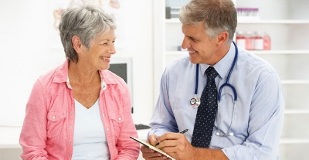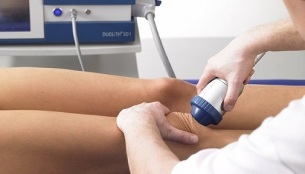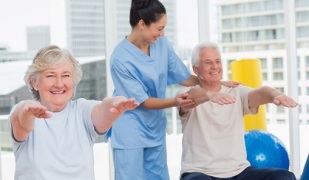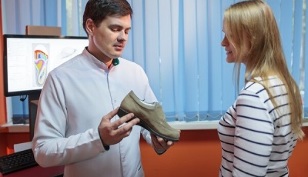
Arthrosis indicates joint damage and degenerative-dystrophic changes in it. This requires efficient and timely treatment. This may include complex conservative methods or imply the need for surgical intervention.
Arthrosis is a chronic degenerative-dystrophic disease. It involves the destruction of cartilage and pathological changes in the capsule, synovium, ligament apparatus and adjacent bone structure. Pathology requires an integrated approach to treatment.
Medicine
One of the main areas of conservative treatment for arthrosis is the use of medications. The following medications are usually prescribed:
- Nonsteroidal anti-inflammatory drugs. They relieve inflammation, pain and fever.
- Glucocorticosteroids. The drug also relieves inflammation and pain, but is more effective.
- Pain medication. These include analgesics and some NSAIDs.
- Chondroprotectors. Such drugs are used in long courses. They are needed for the restoration of the affected cartilage structure.
- Muscle relaxation and antispasmodics. This medicine also relieves pain by relieving muscle cramps.
- If arthrosis is the result of gout, then anti-gout medication is needed.
- Vasodilator. Such drugs have a vasodilating effect.
- Compresses are effective in treating arthrosis, in which medical bile and other methods are used.
- Vitamin and mineral complex. They are needed to activate immunity, normalize material metabolism and metabolic processes, replenish lost elements and assimilate them. Calcium supplements are usually prescribed.
Individual medication choices are often wrong. The attending physician should prescribe medication and determine the nature of its use.
Physiotherapy
Treatment of arthrosis usually involves a variety of physiotherapy procedures. They are used as part of conservative therapy and are prescribed after surgery to speed recovery and reduce the risk of complications.
The following procedure is effective for arthrosis:

- laser therapy- exposure to heat to stimulate regrowth;
- magnetotherapy- improves vascular tone, activates metabolic processes, accelerates recovery, relieves inflammation;
- ozokeritotherapy- warming to improve microcirculation and relieve pain;
- electrophoresis- administration of drugs through electric current;
- cryotherapy- exposure to low temperatures to relieve swelling, pain, reduce muscle tone;
- ultrasound- exposure to high frequency noise to increase material metabolism;
- UHF therapy- softening of calcium deposits, normalization of substance metabolism, reduction of edema;
- homeosiniatry- introduction of homeopathic remedies to biologically active points.
Physiotherapy procedures have contraindications. These include exacerbating inflammatory processes, pregnancy, active tuberculosis. There are also some restrictions for individual procedures.
Sort
Massage is used to relieve arthrosis or in the subacute time. In acute illness, such treatment is excluded, as the affected joint requires complete rest.
Massage for arthrosis has the following effects:
- relieves pain;
- mobility restoration, stiffness removal;
- activation of blood circulation and lymph flow;
- prevention of muscle atrophy, strengthening of muscle corset;
- increased metabolic processes and tissue trophism.
The specialty of massage depends on the affected joint. However, such therapy should be performed exclusively by a qualified specialist. Before massaging, he must assess the level of mobility, muscle condition, identify contractions, ankylosis, pain points.
The effectiveness of massage is provided by the course application. The number of sessions is determined individually. Periodically, massage courses need to be repeated - the frequency is also individually selected.
exercise therapy
Physiotherapy is actively used for arthrosis. It is needed to activate blood circulation and metabolic processes, restore joint mobility, and strengthen muscle corsets. In the early stages, exercise therapy should be performed under the supervision of an instructor.
In the future, you can do gymnastics at home:

- Lie on your back on a firm surface and stretch your legs. Bend one foot at the knee, keeping the foot at a height of 5-10 cm from the floor. Fix this position for 5 seconds, returning to starting position. Perform 5 repetitions alternately on each leg.
- Starting position is the same. Bend one leg and press your hand to the body. Fix it for a while. Then place your feet on the floor and slowly straighten your limbs. Perform 10-15 repetitions for each leg.
- Starting position is the same. Lift your straight legs 25-30 cm above the floor and fix for a few seconds. Return to starting position. Perform 20-30 repetitions on each leg alternately.
- Lying on your stomach. Bend the knees alternately, trying to reach the buttocks with the heels, but without lifting the hips off the floor. Perform 20-50 repetitions for each leg.
- Starting position is the same. Bend your knees alternately, straightening yourself for a few seconds at the worst level. Do 10 repetitions for each leg.
- Sit and straighten your back. Alternately bend and bend the legs, maintaining a moderate level. In the future, you can exercise with a little weight.
- Starting position is the same. Lift your legs to form the right angle. Fix for 3 seconds and return to starting position. Do 10 repetitions for each leg.
Osteoarthritis can affect different joints, so the set of exercises in each case should be special. It should be developed by a specialist, taking into account the individual characteristics of the patient and his or her disease.
All exercises should be done smoothly, sharp movements are excluded. During gymnastics it is necessary to monitor your breathing - it should be calm and measured.
Lifestyle
Treatment of arthrosis involves several lifestyle changes:
- If you are overweight, you need to normalize it. This moment is very important in case of damage to the lower leg.
- Moderate physical activity. High loads should be excluded, therefore, you should not engage in professional sports. The best options are physiotherapy exercises and regular walking.
- Concern for your health. Treatment of chronic diseases, regular intake of vitamin-mineral complexes, preventive examinations by a doctor are necessary.
- Choice of the right clothes and shoes. One should not feel ashamed. Tight clothing is filled with blood stasis, which is dangerous with arthrosis. Women should avoid high heels, shoes should be stable.
- Proper organization of beds and workplaces. All furniture must be comfortable. It should provide such a body position that does not slow down blood circulation, does not cause limb flow. If you have mobility problems, you should equip your home with special handles and handles.
Diet
With arthrosis, it is very important to follow a proper diet. Dietary characteristics are individual and depend on many factors.
The principles of general nutrition are as follows:
- Fractional nutrition. You need 5-6 meals a day, and portions must be small.
- Proper metabolism is guaranteed with a sufficient amount of carbohydrates. Emphasis should be placed on complex carbohydrates - vegetables, fruits, berries, cereals.
- Elimination of simple carbohydrates - sugar, sweets.
- Vegetable fats are needed to speed up metabolic processes. For butter, only natural products are useful.
- To restore cartilage structure, it is useful to use jelly meat, gelatin based gelatin.
- For cooking, you need to limit cooking, cooking and steam cooking.
- Exclusion of spicy, salty, fatty, fried foods from the diet. Rejection of fatty meats, fast food, corn oil.
- Nutrition should be enriched with milk, cottage cheese, dairy products and other fermented milk. They should be fat-free or low-fat.
- You need foods rich in zinc and magnesium - liver, fish, nuts, pumpkin, legumes.
- Oranges and peppers are good sources of antioxidants. To relieve inflammation, you need to use pomegranate, pineapple.
Special orthopedic equipment
In the treatment of arthrosis, various tools are often used to simplify the patient's life and reduce the risk of some complications.
The following construction is used in orthopedics:

- Cane - used to redistribute the load in the event of damage to the lower leg. It is usually used in the last stages of the disease, even after surgery.
- Orthoses - used to repair joints. This allows you to reduce or adjust the movement of the joint, gradually increasing it.
- Bandages - also used to repair joints, after-injury and surgical advantages.
- Corsets are used to fix and straighten the trunk, especially in the case of hip joints.
- Heel heel - provides protection, reduces load.
- Liner for flat foot correction, foot relief.
- Correction for deformed fingers.
- Silicone protector to protect deformed fingers.
If arthrosis is caused by flat feet, orthopedic shoes and special soles should be used. Such measures are also required in the event of damage to the lower extremities to reduce the risk of complications.
Joint elongation
This technique is called attraction. It can be manual or hardware. Traction is usually used when the hip or knee joint is affected.
Attraction implies course application. On average, it takes 10-12 sessions. It can be done daily or every day.
The shared connection is a temporary measure and should be repeated periodically. With arthrosis, 2 courses are usually conducted annually.
Traditional medicine
The use of traditional medicine is appropriate as an additional indication in treatment.
The following recipe is effective for arthrosis:
- Compress with cabbage or carrot leaves. The selected sheets must be washed or chopped in several places, rubbed into the affected area, fitted with foil and covered. It is also effective for dipping leaves into honey. Such compresses should be stored for several hours and done several times a day.
- Mix equal parts iodine (5%), ammonia (10%), medical bile, glycerin and possibly honey. Mix the ingredients and place in a dark place for a week and a half. Before use, shake the mixture and heat the volume required in a water bath. Moisten the napkin in the composition, apply to the affected area, fix with cellophane and insulation. Make a compress at night until it recovers.
- 50 g of dried elecampane root pour half a glass of vodka and leave for 2 weeks in the dark. Rub sore joints with the resulting product.
- Grind the egg yolks into a powder, mix with kefir to make a thick mixture. Wrap with linen and apply to the affected area, fix with polyethylene and strengthen. Apply compresses daily and keep for 2. 5 hours.
- Mix honey equal parts glycerin, alcohol and iodine. Apply the mixture gently with a cotton swab, moving from the bottom up.
- Pour a handful of rolled wheat with half a liter of water and boil for 10 minutes. Apply warm to the affected area, fix with foil and insulation. Hold for an hour.
Natural remedies also have contraindications and side effects. Each new product must be used with caution, starting with the minimum dose and duration of use.
Surgical Treatment
Surgical intervention is required in the event of serious pathological changes, the development of serious complications, and the ineffectiveness of conservative approaches.
Surgical treatment of arthrosis can be done in the following ways:
- Arthroplasty- restoration of articular surface. The indication can be ankylosis, contracture. Such an operation is only possible if there is no acute inflammatory process.
- Arthrotomy- opens the joint to remove foreign bodies, endoprosthetics, purulent contents.
- Arthrodesis- ankylosis (joint immobility) is artificially created. The operation can be performed intra- and extra-articular.
- Resection- partial or complete removal of the articular and synovium surfaces to create movement in the joint.
- Arthrorisis- creates conditions to limit joint movement.
- Endoprosthetics- implant placement for complete or partial replacement of the affected joint.
- Periarticular osteotomy- filing a bone and exposing it at a certain angle. This step allows you to move the center of gravity and redistribute the load.
Arthrosis is a serious disease that causes irreversible changes. It is necessary to start adequate treatment as early as possible. This can be conservative or surgical and involves a variety of different steps. The characteristics of the therapy are determined for each patient individually.

















































